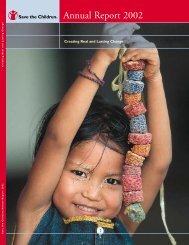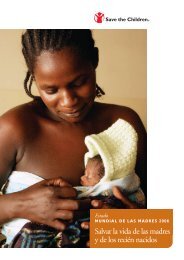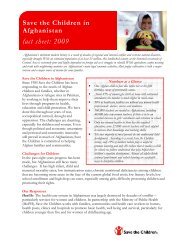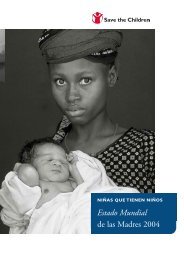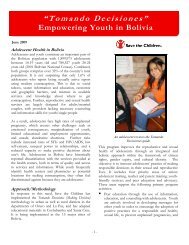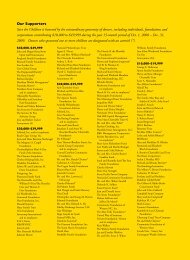Adolescent Sexual and Reproductive Health Toolkit for - UNFPA
Adolescent Sexual and Reproductive Health Toolkit for - UNFPA
Adolescent Sexual and Reproductive Health Toolkit for - UNFPA
You also want an ePaper? Increase the reach of your titles
YUMPU automatically turns print PDFs into web optimized ePapers that Google loves.
Situational Analysis <strong>for</strong> <strong>Adolescent</strong> <strong>Sexual</strong> <strong>and</strong><br />
<strong>Reproductive</strong> <strong>Health</strong> in Emergency Situations<br />
After an emergency situation has stabilized, a situational<br />
analysis will provide in<strong>for</strong>mation about the baseline<br />
status of adolescent RH needs <strong>and</strong> services <strong>and</strong> will<br />
help the agency prioritize interventions as comprehensive<br />
RH services are introduced. Situational<br />
analyses may use several methods of data collection,<br />
including secondary data, in-depth interviews,<br />
focus group discussions, community mapping,<br />
<strong>and</strong> facility assessments.<br />
As mentioned in the introduction to this section,<br />
there are certain ethical considerations that must<br />
be taken into account when conducting a situational<br />
analysis. If all of the ethical requirements cannot be<br />
met, then it is inappropriate to proceed with the<br />
situational analysis.<br />
Example: Focus group discussions (FGD)<br />
Focus group discussions (FGDs) require a significant<br />
amount of planning <strong>and</strong> preparation. Selection of the<br />
discussion participants is important. Participants in a<br />
focus group should be of similar age <strong>and</strong> sex, have<br />
comparable levels of education, speak the same<br />
language <strong>and</strong> be from similar socio-economic<br />
backgrounds. Discussions conducted as part of an<br />
assessment <strong>for</strong> an ASRH program, <strong>for</strong> example, may<br />
be held with separate focus groups of adolescent<br />
boys, unmarried adolescent girls, married adolescent<br />
girls, CAAFAG, separated boys, etc. The ideal number<br />
of participants per FGD should be 8-10 persons. In<br />
addition to the focus group participants, there<br />
should be one discussion leader, who is responsible<br />
<strong>for</strong> asking the questions <strong>and</strong> guiding the encounter,<br />
<strong>and</strong> one reporter, who is responsible <strong>for</strong> documenting<br />
all that is said during the course of the discussion.<br />
The participants, leader <strong>and</strong> reporter should sit in a<br />
circle to encourage equal participation <strong>and</strong> to discourage<br />
the perception that any individual is<br />
dominant over another.<br />
Prior to conducting the FGD, the objective of the<br />
discussion should be determined <strong>and</strong> the question<br />
guide should be developed. The ideal number of<br />
questions to be asked during an FGD is 10-12 <strong>and</strong><br />
adequate time should be set aside to ask the questions<br />
<strong>and</strong> allow <strong>for</strong> in-depth discussion. If too little<br />
time is allocated or too many questions are asked,<br />
the in<strong>for</strong>mation obtained from the FGD may be<br />
superficial <strong>and</strong> of little benefit to the program. In<br />
general, a minimum of two discussions should be<br />
held with each focus group, <strong>and</strong> discussions should<br />
be held with additional participants within each<br />
focus group until no new in<strong>for</strong>mation is obtained.<br />
(Additional guidance on how to select participants,<br />
conduct FGDs <strong>and</strong> analyze the data can be found in the<br />
“Selected readings,” referenced at the end of this section.)<br />
The following matrix illustrates the types of questions<br />
that can be asked of stakeholders during focus group<br />
discussions to gather in<strong>for</strong>mation on the RH needs<br />
<strong>and</strong> practices of adolescents. For each focus group,<br />
program managers should select a maximum of 10-12<br />
questions from the sample <strong>and</strong> adapt them to fit the<br />
context of the situation.<br />
Assessment Tools<br />
57




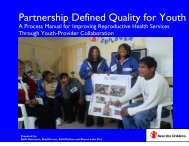

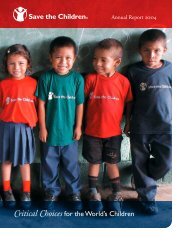
![View full document [PDF 3.39 MB] - PreventionWeb](https://img.yumpu.com/27308954/1/190x245/view-full-document-pdf-339-mb-preventionweb.jpg?quality=85)
